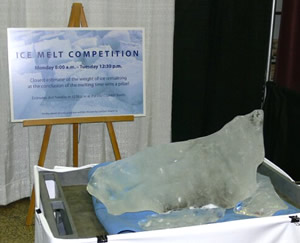 |
AAPT Winter Meeting 2006 |
 |
JANUARY 2006 ICE MELT COMPETITION
Estimates by 7:00 PM Monday - AAPT Exhibit Booth

Given
A large "chunk" of glacier ice on display in the Exhibition Hall: 11 hours on Monday, January 23 8:00 a.m.- 7:00 p.m.) plus 4.5 hours on Tuesday, January 24 (8:00 a.m.-12:SQ p.m.). The ice will be placed in a freezer overnight at a temperature of 27 dqrees.
Task
Estimate how much the 'chunk" will weigh at the conclusion of the melting time at 12:30pm on Tuesday. Winner will be announced Tuesday at 4:30pm.
Theory
A piece of ice will melt due to heat transfer from its surroundings through convection, conduction, and radiation. Since we are conducting this melt inside the Egan (and out of the direct radiation of the sun) we can neglect the process of radiation. Conduction is the transfer of heat from a warmer to a cooler body through direct contact. In our case, heat would be conducted from the table to the base of the ice "chunk", Finally, convection is the transfer of heat from the air to the ice surface. It is governed by the turbulence of the air around the ice, the surface area of the ice exposed to the air, and the heat transfer coefficient between the air and ice. This is the dominant heat transfer mechanism for our melting "chunk" scenario. As heat energy is transferred from the air to the ice surface, it will me1t this energy is used to overcome the latent heat of fusion (or melting). In order for ice to melt, it must first be brought to the melting temperature. The amount of energy required to raise the temperature of a ice is related to its specific heat. Once brought to the melting temperature, additional heat energy will result in the change of phase from solid to liquid water.